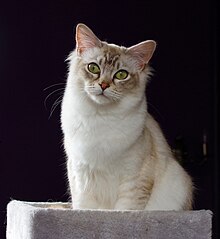| Tiffanie | |
|---|---|
 A black silver male Tiffanie | |
| Other names | Asian Semi-longhair, Asian Longhair, Burmilla Longhair |
| Origin | |
| Breed standards | |
| WCF | standard |
| ACF | standard |
| GCCF | standard |
| LOOF | standard |
| SACC | [https://en.woc.center/articles/standards-tif/ WOC standard, ANCATS standard standard] |
| Notes | |
In ACF and ANCATS only in silver or golden tipped and shaded. | |
| Domestic cat (Felis catus) | |
The Tiffanie[1][2] is a cat breed similar to the Asian Shorthair except it has semi-long fur length. The breed belongs to the Asian Group[3][4][5] and is generally recognised in any of the Asian Shorthair or Burmese colours and patterns. Like the other cats in the Asian Group, the breed was developed during the 1980s in the United Kingdom by crossbreeding a Persian Chinchilla and a Burmese.[2][3][4][5][6]
In cat registries that recognise the breed, it is officially registered under the name Tiffanie[1][7][8] or within the Asian Group as Tiffanie[9]or Asian Longhair.[10] In some registries the colouration is restricted to silver or golden tipped or shaded, and the breed is registered as Burmilla Longhair[11] or Australian Tiffanie.[12][13] Among the cat fancy the breed is also known as the Asian Semi-longhair.
The Tiffanie is often confused with the now extinct and unrelated Chantilly-Tiffany, or Foreign Longhair, a longhaired North American breed originating from chocolate-brown cats of unknown origin.[2] Similarly, the Tiffany in the NZCF (New Zealand) refers to a Burmese longhair.[14][15][16]
History[edit]



Origin[edit]
The Tiffanie was developed in the 1980s in the United Kingdom as a longhaired version of the Asian Shorthair.[2][6] The breed origins can be traced back to matings between a Persian Chinchilla and a Burmese.[6]
Recognition[edit]
It has full recognition in the GCCF,[9][17] LOOF,[10] SACC,[7] preliminary status with the WCF,[18] and has registration only status with The International Cat Association.[8] The Australian Tiffanie is recognised by ANCATS[12][13] and the Burmilla longhair by ACF,[11] which are distinctly different in colour to the Asian Semi-longhair Tiffanie as these only come in silver or golden tipped or shaded.[11][12][13]
Australian Tiffanie[edit]
One governing body in Australia (Waratah National Cat Alliance, WNCA, now the Australian National Cats Inc., ANCATS) uses the name Australian Tiffanie; however, international acceptance and standardisation did not follow. It is different from the European Tiffanie and the North-American Chantilly-Tiffany. The Tiffanie from the UK is also originating from crossbreeding chinchilla Persian and Burmese cats. However, Australian Tiffanies are essentially longhair Burmillas, as they only come in silver or golden tipped or shaded. The breed is separately developed in the late-1990s in Australia from European Tiffanie cats by breeding them back to the chinchilla Persian.[12][13] Therefore, many Australian Tiffanies contain more than three-quarters chinchilla Persian and retain the appearance and temperament of the Old-Fashioned chinchilla Persian. To summarise, the Australian Tiffanie and Tiffanie from the UK are both developed from crossbreeding chinchilla Persians and Burmeses, but the Australian version contains more chinchilla Persian. Consequently, only silver and golden tipped and shaded is allowed in the Australian Tiffanie.[12] The name's use is declining in favour, due to the lax standards for the breed name, the lack of unique identity and the varied genetic makeup.
References[edit]
- ^ a b "Breed Comparisons - Tiffanie | World Cat Congress". worldcatcongress.org. World Cat Congress. Retrieved 17 September 2023.
- ^ a b c d Baggaley, Ann; Goddard, Jolyon; John, Katie (2014). The cat encyclopedia - the definitive visual guide (1st American ed.). London: Dorling Kindersley. ISBN 9781465419590. OCLC 859882932.
- ^ a b "Asian Group Breed Advisory Committee". www.asiangroupbac.co.uk. Retrieved 17 September 2023.
- ^ a b "Asian Group Cat Society – Asian Cats: Burmillas, Tabbies, Smokes, Selfs and Tiffanies". Retrieved 17 September 2023.
- ^ a b World Cat Congress (2017). The Royal Canin Cat Encyclopedia. France: Royal Canin.
- ^ a b c Somerville, Louisa (2007). The Ultimate Guide to Cat Breeds. Edison, N.J.: Chartwell Books. p. 98. ISBN 9780785822646.
- ^ a b "Breed Standard of Points - Tiffanie". TSACC.org.za. Retrieved 17 September 2023.
- ^ a b "Registration Rules - Version A 19-Jan-2023 4". TICA.org. Version A 19-Jan-2023 4. Under 37.7 Category VI: Experimental (Developing) Breeds - 307.7 Category VI Breeds. The International Cat Association. 19 January 2023. Retrieved 17 September 2023.
- ^ a b "Breed standards" (PDF). The Governing Council of the Cat Fancy. Archived from the original (PDF) on 15 November 2011. Retrieved 22 May 2012.
- ^ a b "Asian, English Burmese & Burmilla". m.loof.asso.fr. Livre Officiel des Origines Félines. Retrieved 17 September 2023.
- ^ a b c "Breed standard - BURMILLA (Longhair [BML 81] and (Shorthair [BML])" (PDF). acf.asn.au. Australian Cat Federation. June 2023.
- ^ a b c d e "ANCATS National Breed Standards May 2018 - Australian Tiffanie" (PDF). ancats.com.au. Australian National Cats Inc. February 2020. p. 48.
- ^ a b c d "Breeders". www.ancats.com.au. Australian National Cats Inc. Retrieved 17 September 2023.
- ^ "Tiffany". nzcf.com. New Zealand Cat Fancy. Retrieved 17 September 2023.
- ^ "WCF EMS code". WCF.info. World Cat Federation. 5 January 2022. Retrieved 17 September 2023.
- ^ "Tiffany - Breed Standard" (PDF). nzcf.com. New Zealand Cat Fancy. January 2013. Retrieved 18 September 2023.
- ^ "Asian Breed standard" (PDF). Loving Cats Worldwide. Retrieved 22 March 2023.
- ^ "List of breeds admitted in WCF". WCF.info. World Cat Federation. Retrieved 17 September 2023.
External links[edit]
- FBRL Breed Page: Asian
- Asian Cat Association Archived 22 March 2023 at the Wayback Machine
- Asian Group Cat Society